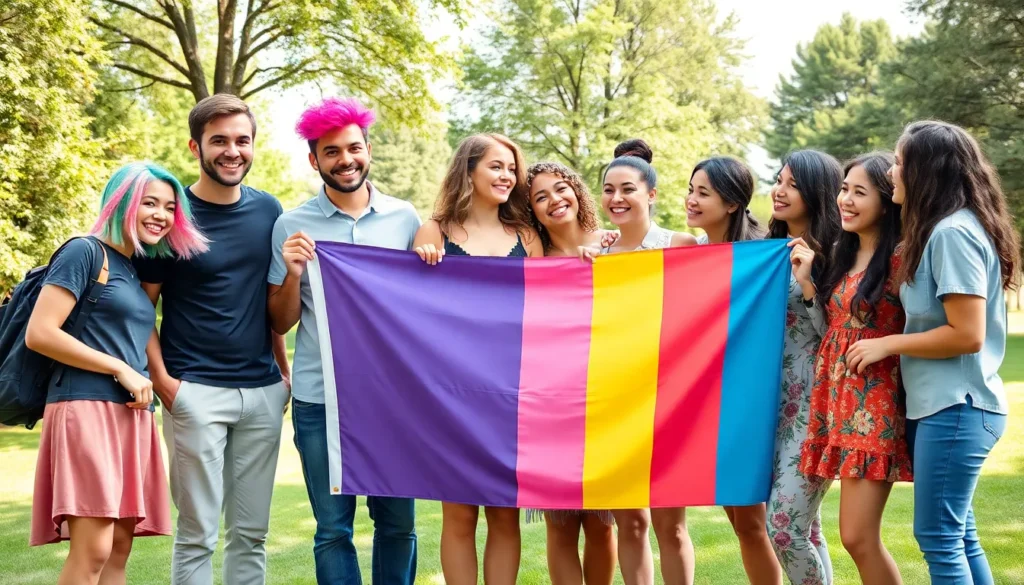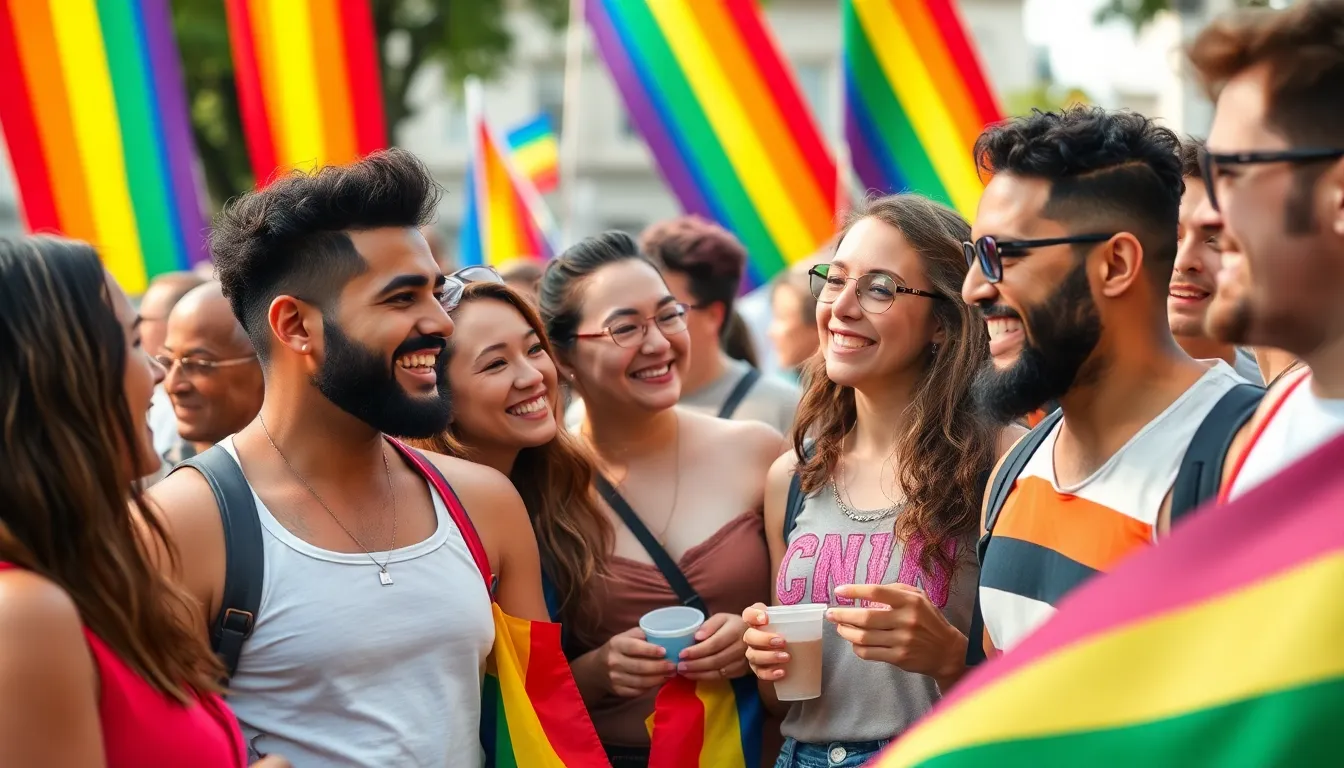Table of Contents
ToggleIn today’s evolving landscape of sexual identities, pansexuality stands as a term that’s gaining increasing recognition. Pansexuality describes individuals who experience attraction regardless of gender identity, meaning they can be attracted to people of any gender or to those who don’t identify with any gender at all.
While sometimes confused with bisexuality, pansexuality has its own distinct meaning and community. The prefix “pan” comes from Greek, meaning “all” or “every,” highlighting how pansexual attraction transcends traditional gender boundaries. This orientation acknowledges the spectrum of gender identities beyond the binary male and female categories.
Understanding pansexuality is important for fostering inclusivity and respecting the diverse ways people experience attraction. As society becomes more aware of different sexual orientations, terms like pansexuality help people find language that accurately describes their experiences.
Understanding Pansexuality: What It Means
Pansexuality describes individuals who experience romantic, emotional, or sexual attraction to people regardless of their gender identity. The term comes from the Greek prefix “pan-” meaning “all,” signifying that pansexual people don’t limit their attraction based on someone’s gender. Unlike other orientations that may focus on specific genders, pansexuality embraces the potential for attraction across the entire gender spectrum.
For pansexual individuals, factors like personality, emotional connection, and shared values typically play more significant roles in attraction than gender identity. This doesn’t mean pansexual people are attracted to everyone they meet—rather, gender simply isn’t a determining factor in who they find attractive. Many pansexual people describe experiencing attraction to the person, not the gender.
Pansexuality acknowledges and embraces the existence of multiple gender identities beyond the traditional binary. This includes attraction to cisgender, transgender, non-binary, genderqueer, genderfluid, and agender individuals. This inclusive approach to attraction aligns with contemporary understanding of gender as a diverse and complex spectrum rather than a simple binary construct.
The pansexual flag, created to represent this orientation, features horizontal stripes in pink (representing attraction to those who identify as female), yellow (attraction to non-binary individuals), and blue (attraction to those who identify as male). This symbol has become an important visual representation at Pride events and in LGBTQ+ communities worldwide.
The History and Evolution of Pansexuality
Pansexuality has evolved significantly throughout history, becoming more recognized and understood in contemporary society. The journey of pansexuality represents an important chapter in the broader narrative of sexual orientation and gender identity recognition.
Origin of the Term
The term “pansexual” combines the Greek prefix “pan-,” meaning “all,” with “sexual,” highlighting attraction to people of all genders. Sigmund Freud first used “pansexual” in the early 20th century, though with a different meaning than today’s understanding. Freud used it to describe the view that most human behavior is motivated by sexuality, rather than referring to sexual orientation. The modern definition emerged in the 1970s, gaining momentum alongside growing awareness of gender diversity. The term appeared more frequently in academic literature during the 1990s, coinciding with queer theory’s development and expanding conceptions of gender beyond the binary. By the early 2000s, pansexuality began establishing itself as a distinct sexual orientation within LGBTQ+ communities, offering language that acknowledged attraction across the gender spectrum.
How Recognition Has Grown
Pansexuality’s recognition has expanded dramatically in the 21st century through multiple channels of visibility. Celebrity coming-out stories have significantly boosted awareness, with figures like Miley Cyrus, Janelle Monáe, and Brendon Urie openly identifying as pansexual. Social media platforms have created spaces for pansexual individuals to connect, share experiences, and educate others about their identity. The increased recognition of non-binary and gender non-conforming identities has contributed to pansexuality’s visibility, as more people seek orientation labels that explicitly include attraction to all gender identities. LGBTQ+ organizations have integrated pansexuality into their educational materials and community resources, while media representation in TV shows like “Schitt’s Creek” and “Brooklyn Nine-Nine” has introduced pansexual characters to mainstream audiences. Scientific research has also evolved, with studies on sexual orientation increasingly including pansexuality as a distinct category rather than grouping it under bisexuality or “other” orientations.
Pansexuality vs. Other Sexual Orientations
Pansexuality exists alongside several other sexual orientations within the LGBTQ+ spectrum, each with distinct characteristics and experiences. Understanding these differences helps create more inclusive conversations about sexual identity and attraction.
Differences Between Pansexual and Bisexual
Pansexuality and bisexuality share similarities but differ in key aspects of attraction patterns. Bisexuality typically refers to attraction to two or more genders, often including one’s own gender and other genders. Many bisexual individuals experience varying levels of attraction to different genders and may have preferences. Pansexuality, in contrast, describes attraction regardless of gender, where gender isn’t a determining factor in attraction at all.
The prefix “bi” historically suggested attraction to two genders (men and women), while “pan” means “all,” indicating attraction across the entire gender spectrum. However, modern bisexual communities often define bisexuality more broadly as attraction to multiple genders rather than limiting it to two. Both identities are valid and overlap considerably, with many individuals choosing their label based on which resonates more with their personal experience of attraction.
Pansexuality and the Gender Spectrum
Pansexuality explicitly acknowledges and embraces the full gender spectrum beyond binary classifications. Pansexual individuals can experience attraction to people of any gender identity, including cisgender, transgender, non-binary, genderfluid, agender, and other gender-diverse identities. This orientation inherently recognizes gender as a complex spectrum rather than a binary concept.
Unlike some other orientations that may emphasize gender in attraction patterns, pansexuality centers on the person rather than their gender identity. Many pansexual people describe being attracted to someone’s personality, emotional connection, or other qualities first, with gender playing little to no role in their attraction. This perspective aligns with evolving understandings of gender diversity and challenges traditional notions that sexual attraction must be defined by gender categories.
Pansexual Representation in Media and Culture
Pansexual representation in media and culture has expanded significantly in recent years, offering greater visibility for this sexual orientation. This increased representation helps normalize pansexuality and provides important role models for individuals exploring their own identities.
Notable Pansexual Public Figures
Several celebrities have publicly identified as pansexual, creating powerful moments of visibility and education. Janelle Monáe came out as pansexual in a 2018 Rolling Stone interview, describing herself as “a free-ass motherfucker” who had been “in relationships with both men and women.” Miley Cyrus has openly discussed her pansexuality since 2015, emphasizing how she doesn’t “relate to being boy or girl” when it comes to attraction. Other public figures who identify as pansexual include actress Bella Thorne, musician Brendon Urie of Panic! at the Disco, and model Cara Delevingne. These celebrities’ willingness to share their identities has sparked important conversations about pansexuality in mainstream media outlets, social platforms, and entertainment publications.
Portrayal in Television and Film
Television and film representations of pansexual characters have grown more nuanced and prevalent over the past decade. The character David Rose from “Schitt’s Creek,” portrayed by Dan Levy, famously explained pansexuality using a wine analogy: “I like the wine and not the label.” Netflix’s “Sex Education” features Cal, a non-binary character who discusses pansexuality openly. In animation, characters like Deadpool from Marvel properties and Jack Harkness from “Doctor Who” and “Torchwood” embody pansexual attraction without limiting their potential partners by gender. TV shows like “Brooklyn Nine-Nine,” “The Bold Type,” and “Transparent” have incorporated pansexual characters whose storylines extend beyond their sexual orientation, presenting fully developed individuals rather than one-dimensional representations. These portrayals help audiences understand pansexuality as part of a broader spectrum of human attraction and connection.
Challenges Faced by the Pansexual Community
Pansexual individuals encounter unique obstacles in their journey toward recognition and acceptance. These challenges stem from societal misunderstandings, lack of visibility, and the erasure of pansexual identities in both mainstream culture and within LGBTQ+ spaces.
Misconceptions and Stereotypes
Pansexual people regularly combat harmful misconceptions about their identity. Common stereotypes include the belief that pansexuality is “just a phase” or merely a trendy label, dismissing the legitimate experiences of those who identify as pansexual. Many face accusations of being “confused bisexuals” or “unable to make up their minds,” which invalidates their specific attraction patterns. The hypersexualization of pansexual individuals is another pervasive stereotype, with many assuming they’re promiscuous or willing to engage sexually with anyone—conflating attraction potential with actual behavior. These misconceptions often lead to microaggressions such as invasive questions about sexual preferences or partners, creating uncomfortable social situations for pansexual people in daily interactions.
Issues of Visibility and Acceptance
Pansexuality suffers from significant invisibility in mainstream media and public discourse. Unlike more widely recognized sexual orientations, pansexuality receives limited representation, leaving many people unaware of its existence or meaning. This invisibility extends to educational materials, where pansexuality is often omitted from sex education curricula and LGBTQ+ awareness programs. Within the LGBTQ+ community itself, pansexual individuals sometimes experience exclusion or dismissal of their identity as not being “real” or distinct enough to warrant recognition. The concept of “pansexual erasure” occurs when pansexual people are mislabeled as bisexual or gay/lesbian, erasing their specific identity and experiences. These visibility challenges create barriers to community building, with pansexual people struggling to find others who share their experiences and understand their unique perspective on attraction and relationships.
Supporting Pansexual Individuals
Supporting pansexual individuals involves creating inclusive environments where their identity is recognized, respected, and celebrated. Allies play a crucial role in advocating for pansexual visibility and combating the erasure and misconceptions that many pansexual people experience.
Being an Ally
Being an effective ally to pansexual individuals starts with education and understanding. Allies should familiarize themselves with pansexuality as a valid sexual orientation that involves attraction regardless of gender identity. This includes learning the correct terminology and avoiding common misconceptions that conflate pansexuality with promiscuity or indecisiveness.
Active listening forms the foundation of allyship. When pansexual individuals share their experiences, allies respond with empathy and without judgment. They avoid invalidating statements like “it’s just a phase” or “you’re really just bisexual,” recognizing that such comments contribute to identity erasure.
Allies practice respectful language by using a person’s preferred pronouns and avoiding assumptions about their partners or relationship structures. They correct others who misgender pansexual individuals or perpetuate stereotypes, serving as advocates in spaces where pansexual voices might be marginalized.
Visible support makes a significant difference in creating affirming environments. Allies display pansexual pride symbols, such as the pink, yellow, and blue flag, in appropriate contexts. They celebrate Pansexual Awareness Day (May 24) and Pansexual Pride Day (December 8) to increase visibility and education about pansexuality.
Resources and Communities
Pansexual individuals benefit from connecting with supportive communities both online and offline. Digital platforms like Reddit’s r/pansexual, Tumblr’s pansexuality tags, and Discord servers dedicated to pansexual individuals provide spaces for sharing experiences, asking questions, and building relationships with others who share similar identities.
LGBTQ+ organizations like PFLAG, GLAAD, and The Trevor Project offer resources specifically addressing pansexuality within their broader educational materials. These organizations provide helplines, chat services, and educational resources for pansexual individuals and their families navigating questions about identity and coming out.
Local LGBTQ+ community centers in many cities host support groups and social events where pansexual individuals can connect with peers. University campuses often have LGBTQ+ student organizations that welcome pansexual members and provide educational programming about diverse sexual orientations.
Mental health resources tailored to LGBTQ+ individuals help address the specific challenges pansexual people may face. Therapist directories like Psychology Today and the National Queer and Trans Therapists of Color Network feature filters to find therapists experienced with pansexual clients and other sexual orientation concerns.
Educational materials including books like “The ABCs of LGBT+” by Ashley Mardell and “Queer: A Graphic History” by Meg-John Barker provide accessible information about pansexuality within the broader context of sexual orientation and gender identity. These resources help both pansexual individuals and allies deepen their understanding of pansexual experiences.
Conclusion
Pansexuality represents a vital part of our diverse human experience of attraction. As society continues to evolve in its understanding of gender and sexuality, recognizing pansexuality helps create more inclusive communities where everyone feels valued.
The journey toward acceptance isn’t complete, but increased visibility through media representation and celebrity voices has sparked meaningful conversations. Supporting pansexual individuals means acknowledging their unique experiences and challenging outdated binary concepts of attraction.
By embracing the full spectrum of human connection that transcends gender boundaries, we move toward a world where love and attraction are celebrated in all their forms. The pansexual perspective reminds us that ultimately, it’s the person—not their gender—that matters most in forming meaningful relationships.




